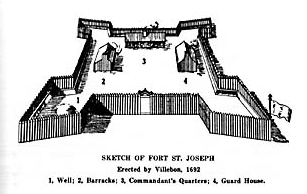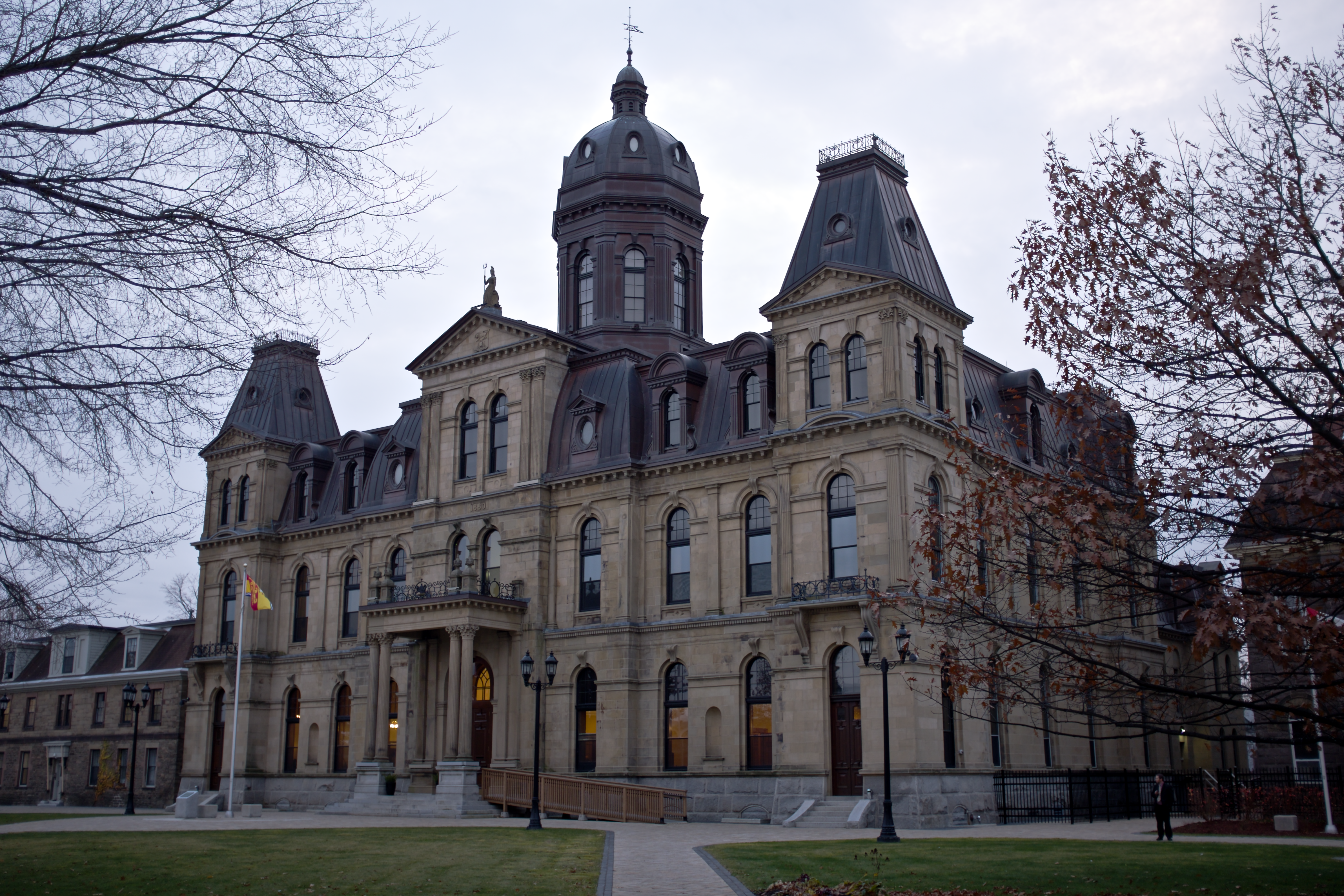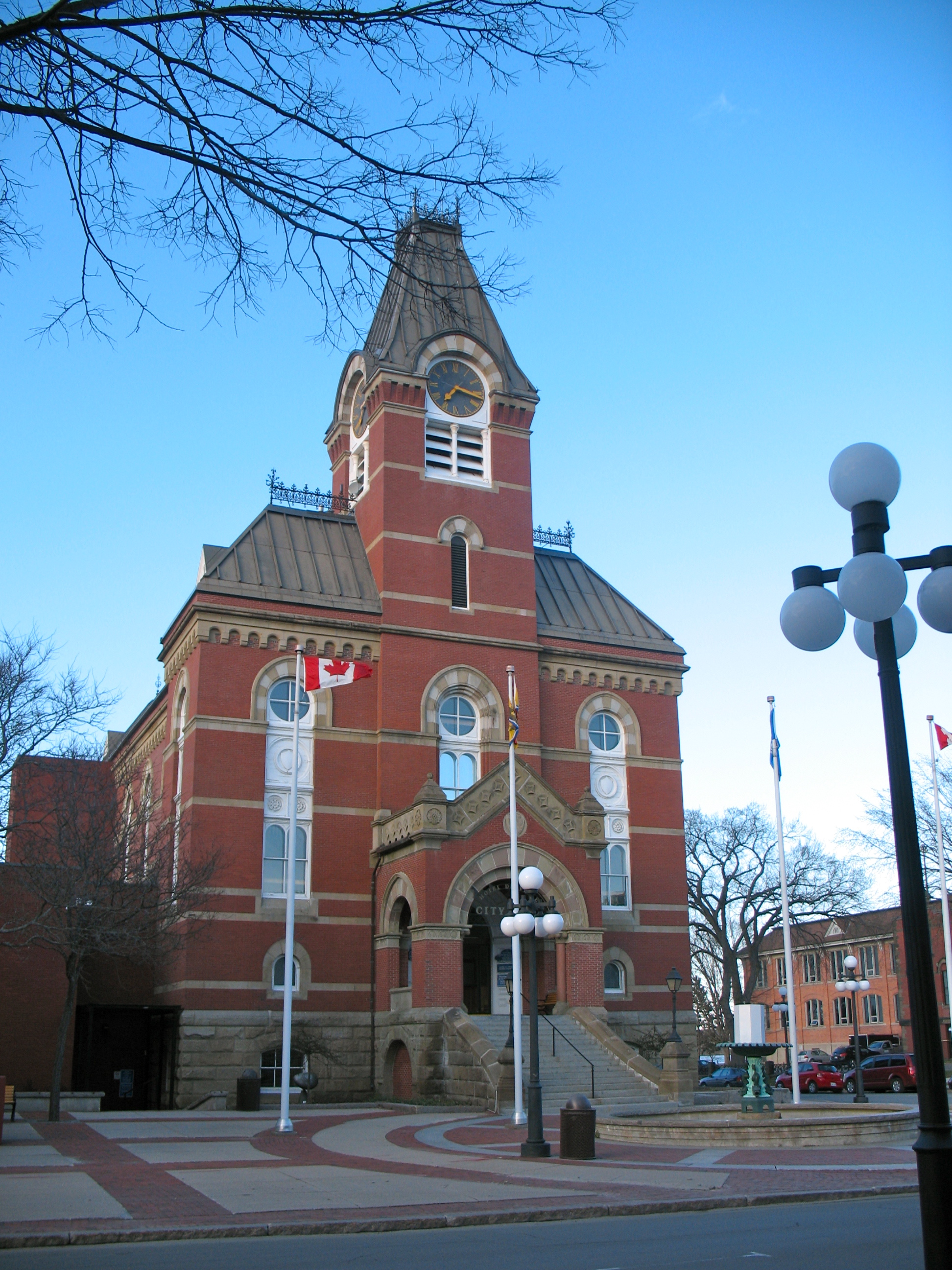History of Fredericton on:
[Wikipedia]
[Google]
[Amazon]
The history of Fredericton stretches from prehistory to the modern day. Fredericton,
 The first European contact in the area was by the French in the late 17th Century, who granted the land to Joseph de Villebon. In 1692, he built a fort (
The first European contact in the area was by the French in the late 17th Century, who granted the land to Joseph de Villebon. In 1692, he built a fort (
 When New Brunswick became a separate colony from Nova Scotia in 1784, Ste. Anne's Point became the provincial capital, winning out over Parrtown (present-day Saint John) due to its central inland location meaning it was less prone to American attack from the sea.
The site of Fredericton was designated as provincial capital by Governor Guy Carleton on 22 February 1785. King's College (now the
When New Brunswick became a separate colony from Nova Scotia in 1784, Ste. Anne's Point became the provincial capital, winning out over Parrtown (present-day Saint John) due to its central inland location meaning it was less prone to American attack from the sea.
The site of Fredericton was designated as provincial capital by Governor Guy Carleton on 22 February 1785. King's College (now the
 In 1829, the Old Arts Building was completed to house King's College (later to become the
In 1829, the Old Arts Building was completed to house King's College (later to become the
New Brunswick
New Brunswick (french: Nouveau-Brunswick, , locally ) is one of the thirteen provinces and territories of Canada. It is one of the three Maritime provinces and one of the four Atlantic provinces. It is the only province with both English and ...
was first inhabited by the Mi'kmaq
The Mi'kmaq (also ''Mi'gmaq'', ''Lnu'', ''Miꞌkmaw'' or ''Miꞌgmaw''; ; ) are a First Nations people of the Northeastern Woodlands, indigenous to the areas of Canada's Atlantic Provinces and the Gaspé Peninsula of Quebec as well as the nort ...
and Maliseet peoples. European settlement of the area began with the construction of Fort Nashwaak
Fort Nashwaak (also known as Fort Naxoat, Fort St. Joseph) was the capital of Acadia and is now a National Historic Site of Canada in present-day Fredericton, New Brunswick, Canada. It was located strategically up the Saint John River and clos ...
by the French in 1692. In 1783, the United Empire Loyalists
United Empire Loyalists (or simply Loyalists) is an honorific title which was first given by the 1st Lord Dorchester, the Governor of Quebec, and Governor General of The Canadas, to American Loyalists who resettled in British North America dur ...
settled Ste. Anne's Point, and in the next year, renamed the settlement Frederick's Town. The name was later shorted to Fredericton in April 1785.
Fredericton was incorporated into a city in 1973.
Early history
The area of the present-day City of Fredericton was first used for seasonal farming by theMi'kmaq
The Mi'kmaq (also ''Mi'gmaq'', ''Lnu'', ''Miꞌkmaw'' or ''Miꞌgmaw''; ; ) are a First Nations people of the Northeastern Woodlands, indigenous to the areas of Canada's Atlantic Provinces and the Gaspé Peninsula of Quebec as well as the nort ...
and Maliseet peoples. Maize
Maize ( ; ''Zea mays'' subsp. ''mays'', from es, maíz after tnq, mahiz), also known as corn (North American and Australian English), is a cereal grain first domesticated by indigenous peoples in southern Mexico about 10,000 years ago. The ...
was a primary crop they grew in the area. In a sense, the site of Fredericton served as a sort of capital for First Nations in the area. Aucpaque, the "principal village" of the Aboriginals in the area, was located a few kilometres up river from the site of present-day Fredericton.
17th century
 The first European contact in the area was by the French in the late 17th Century, who granted the land to Joseph de Villebon. In 1692, he built a fort (
The first European contact in the area was by the French in the late 17th Century, who granted the land to Joseph de Villebon. In 1692, he built a fort (Fort Nashwaak
Fort Nashwaak (also known as Fort Naxoat, Fort St. Joseph) was the capital of Acadia and is now a National Historic Site of Canada in present-day Fredericton, New Brunswick, Canada. It was located strategically up the Saint John River and clos ...
) on the north side of the Saint John River, at the mouth of the Nashwaak River
The Nashwaak River, located in west-central New Brunswick, Canada, is a tributary of the Saint John River. It is 113 kilometres long. The river rises from Nashwaak Lake (southeast of the village of Juniper) and flows south and east through uni ...
. For a period, Fort Nashwaak
Fort Nashwaak (also known as Fort Naxoat, Fort St. Joseph) was the capital of Acadia and is now a National Historic Site of Canada in present-day Fredericton, New Brunswick, Canada. It was located strategically up the Saint John River and clos ...
served as the capital of the French colony of Acadia
Acadia (french: link=no, Acadie) was a colony of New France in northeastern North America which included parts of what are now the The Maritimes, Maritime provinces, the Gaspé Peninsula and Maine to the Kennebec River. During much of the 17t ...
.
Acadian Governor Villebon, and the location of the Capital of Acadia at Fort Nashwaak on the St. John River, became a source of torment for the settlers of New England. Within weeks of an attack launched from Fort Nashwaak on Pemaquid, Maine (present day Bristol, Maine
Bristol, known from 1632 to 1765 as Pemaquid (; today a village within the town) is a town in Lincoln County, Maine, United States. The population was 2,834 at the 2020 census. A fishing and resort area, Bristol includes the villages of New Har ...
), the New Englanders struck back. In 1696, an expedition under command of Major Benjamin Church set out to destroy Fort Nashwaak (present day Fredericton). Villebon had been alerted and prepared his defences. On 18 October, the British troops arrived opposite the fort, landed three cannons, and assembled earthworks on the south bank of the Nashwaak River. There was a fierce exchange of fire during the two day battle, with the advantage going to the better-sited French guns. The New Englanders were defeated, with 8 soldiers killed and 17 wounded. The French sustained losses of one killed and two wounded. After de Villebon's death in 1700 and a devastating flood, the fort was abandoned.
18th century
The Fredericton area was first permanently settled and named Pointe-Sainte-Anne (often anglicized to Ste. Anne's Point) in 1732 byAcadia
Acadia (french: link=no, Acadie) was a colony of New France in northeastern North America which included parts of what are now the The Maritimes, Maritime provinces, the Gaspé Peninsula and Maine to the Kennebec River. During much of the 17t ...
ns fleeing Nova Scotia
Nova Scotia ( ; ; ) is one of the thirteen provinces and territories of Canada. It is one of the three Maritime provinces and one of the four Atlantic provinces. Nova Scotia is Latin for "New Scotland".
Most of the population are native Eng ...
after the British took over the territory. Their townsite was on the south side of the river, approximately a mile upriver from Fort Nashwaak. The British captured Ste. Anne's Point during the Expulsion of the Acadians
The Expulsion of the Acadians, also known as the Great Upheaval, the Great Expulsion, the Great Deportation, and the Deportation of the Acadians (french: Le Grand Dérangement or ), was the forced removal, by the British, of the Acadian peo ...
, burning the settlement to the ground in the St. John River Campaign
The St. John River campaign occurred during the French and Indian War when Colonel Robert Monckton led a force of 1150 British soldiers to destroy the Acadian settlements along the banks of the Saint John River until they reached the largest v ...
.
British settlement
The British attempted to create a settlement in 1762, although were unsuccessful due to hostility of local Acadian and Aboriginal populations. These settlers ended up building a community down river at what it today the town ofMaugerville
Maugerville (, MAJOR-ville) is a New Brunswick unincorporated community located on the east bank of the Saint John River in Maugerville Parish, Sunbury County, in the Canadian province of New Brunswick. The settlement is located on provincial Ro ...
. However, three fur traders managed to permanently settle there in 1768.
The founding of the City of Fredericton dates from 1783, when the United Empire Loyalists
United Empire Loyalists (or simply Loyalists) is an honorific title which was first given by the 1st Lord Dorchester, the Governor of Quebec, and Governor General of The Canadas, to American Loyalists who resettled in British North America dur ...
settled in Ste. Anne's Point (site of present-day Fredericton) after the American Revolution
The American Revolution was an ideological and political revolution that occurred in British America between 1765 and 1791. The Americans in the Thirteen Colonies formed independent states that defeated the British in the American Revoluti ...
. At the time of the Loyalist settlement, St. Anne's Point was occupied by only three families. About 2,000 Loyalists settled in the area of present-day Fredericton including several army regiments. The first winter was harsh with early and severe snowfalls. Bedding was in short supply and many died during the harsh winter of 1783/84. They were buried in what became the Loyalist cemetery, which is still found on the south bank of the Saint John River. During the following spring – due to deaths and Loyalists leaving for land grants in other regions of the countryside, the numbers of settlers was greatly reduced. Thus, the numbers of the true Loyalist founders is less than commonly believed in popular myth.
A street plan was laid out to the west of the original townsite and approved by Nova Scotia Governor Parr in 1784. The layout was laid out in a detailed map in 1785 which entailed broad streets intersecting at right angles and forming a series of city blocks. This plan came to be known as the "Campbell Plot", named after its designer. However, the streets were not named until 1819. The street plan laid out in the "Campbell Plot" gives downtown Fredericton its characteristic spaciousness today.
 When New Brunswick became a separate colony from Nova Scotia in 1784, Ste. Anne's Point became the provincial capital, winning out over Parrtown (present-day Saint John) due to its central inland location meaning it was less prone to American attack from the sea.
The site of Fredericton was designated as provincial capital by Governor Guy Carleton on 22 February 1785. King's College (now the
When New Brunswick became a separate colony from Nova Scotia in 1784, Ste. Anne's Point became the provincial capital, winning out over Parrtown (present-day Saint John) due to its central inland location meaning it was less prone to American attack from the sea.
The site of Fredericton was designated as provincial capital by Governor Guy Carleton on 22 February 1785. King's College (now the University of New Brunswick
The University of New Brunswick (UNB) is a public university with two primary campuses in Fredericton and Saint John, New Brunswick. It is the oldest English-language university in Canada, and among the oldest public universities in North Ameri ...
) was founded that same year, and the locale was renamed "Frederick's Town", in honour of the second son of King George III
George III (George William Frederick; 4 June 173829 January 1820) was King of Great Britain and of Ireland from 25 October 1760 until the union of the two kingdoms on 1 January 1801, after which he was King of the United Kingdom of Great Br ...
of the United Kingdom, Prince Frederick Augustus, Duke of York. The name was shortened to Fredericton shortly after the city became the official provincial capital of New Brunswick on 25 April 1785.
Within a period of less than three years, the site of Fredericton went from being a sparsely inhabited region to being the capital of the new colony of New Brunswick. While many more people came after the Loyalists, as the numbers of Loyalists settlers who permanently remained on the site was quite small, these Loyalists laid the foundation for Fredericton and its role as provincial capital. This foundation that would be built upon by newcomers and further generations afterwards.
The same attributes that made Fredericton the capital city also made it an ideal spot for a military installation. Many of the original military buildings downtown still stand, and are now tourist attractions. A building was constructed to house the provincial legislative assembly in 1788, but it was destroyed by a fire in 1880. Two years later, the present New Brunswick Legislative Building
The New Brunswick Legislative Building (french: Édifice de l'Assemblée législative du Nouveau-Brunswick) is the home to the Legislative Assembly of New Brunswick, and is located in Fredericton, New Brunswick, Canada. Opened in 1882, the Second ...
was constructed.
19th century
 In 1829, the Old Arts Building was completed to house King's College (later to become the
In 1829, the Old Arts Building was completed to house King's College (later to become the University of New Brunswick
The University of New Brunswick (UNB) is a public university with two primary campuses in Fredericton and Saint John, New Brunswick. It is the oldest English-language university in Canada, and among the oldest public universities in North Ameri ...
). In 1848, Christ Church Cathedral (part of the Church of England
The Church of England (C of E) is the established Christian church in England and the mother church of the international Anglican Communion. It traces its history to the Christian church recorded as existing in the Roman province of Britai ...
) was built, allowing Fredericton to achieve city status.
A Maliseet settlement, today called the St. Mary's First Nation, was founded on the north side of the river in 1847. However the area of this settlement was reduced from its original allocation as the city grew and surrounded it.
Prince Edward, Prince of Wales, visited Fredericton in 1860 and, while there, dedicated Wilmot Park. His brother, Prince Alfred, visited the year following for service on HMS ''Euryalus.
Fredericton City Hall's construction began, on 1 January 1875 and was completed exactly one year later.
During the 19th century Fredericton was home to several industries including the lumber industry. However, over the twentieth century, Fredericton's industrial sector declined and gave way to the universities and the provincial government being the primary employers.
20th century to present
Until Gibson (now referred to as the neighbourhood ofDevon
Devon ( , historically known as Devonshire , ) is a ceremonial and non-metropolitan county in South West England. The most populous settlement in Devon is the city of Plymouth, followed by Devon's county town, the city of Exeter. Devo ...
) was merged with Fredericton in 1945, the corporate limit of the city of Fredericton was restrained to the south side. During the post-war period until the end of the 1970s, Fredericton experienced a significant growth in population as the University of New Brunswick
The University of New Brunswick (UNB) is a public university with two primary campuses in Fredericton and Saint John, New Brunswick. It is the oldest English-language university in Canada, and among the oldest public universities in North Ameri ...
expanded, Saint Thomas University built its Fredericton campus in 1964. As well, new civil service jobs further increased Fredericton's population during this period as the provincial government centralized its functions and grew in size. It was during the 1960s and 1970s that the Hill area was largely developed and new bedroom communities, such as New Maryland, emerged.
In 1973, the city annexed several bedroom communities, such as Nashwaaksis, Marysville, Barker's Point, and Silverwood
Silverwood Theme Park is an amusement park located in the city of Athol in northern Idaho, United States, near the town of Coeur d'Alene, approximately from Spokane, Washington on US 95. Owner Gary Norton opened the park on June 20, 19 ...
. Although all of these names are still in common use, references to simply the "north side" or the "south side" (with the Saint John River being the dividing line) are generally used by residents.
See also
*History of New Brunswick
The history of New Brunswick covers the period from the arrival of the Paleo-Indians thousands of years ago to the present day. Prior to European colonization, the lands encompassing present-day New Brunswick were inhabited for millennia by the s ...
References
Further reading
*McIntyre, Glen, Bruce Oliver and Bob Watson, "A Valuable and Important Place – Fredericton's Loyalist Origins 1783." A Fredericton Historical Research Project, 1983. {{History of Canada navbox Fredericton Fredericton Fredericton Conflicts in Nova Scotia